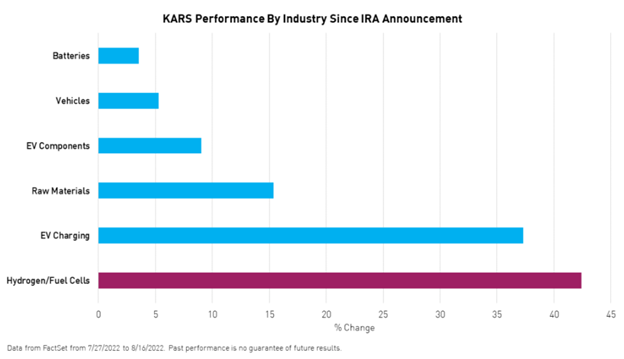The passage of the Inflation Reduction Act and its signing into law on August 16, 2022 brings about a host of changes related to taxation, Medicare prescription drug pricing, and a sweeping climate commitment by the government that could have a major impact for domestic electric vehicle production and interest.
The Inflation Reduction Act is a massive climate bill, the largest to ever be passed in the U.S. at $369 billion in spending dedicated just to climate initiatives. We’ve covered what it means from a carbon allowances angle here, as well as from a green hydrogen perspective here, but the bill also has sizeable incentives for electric vehicle manufacturers and consumers and will likely drive significant EV growth and adoption in the U.S.
“We believe the Act will help accelerate EV adoption in the United States, bringing EVs closer to cost parity with internal combustion engine (ICE) vehicles. The Act is a breath of fresh air for the EV market in the US, which has lagged global peers in recent years,” wrote Anthony Sassine, CFA, senior investment strategist at KraneShares, in a recent paper.
The Inflation Reduction Act (IRA) extends EV tax credits that were set to expire, providing a $7,500 credit through 2032 and dropping the requirement that limited what manufacturer the credit would count for. The tax credits are for individuals that make less than $150,000 a year ($300,000 for families) and will benefit a number of the larger EV producers such as Tesla and GM that were previously frozen out.
However, there are limitations for which EVs qualify; a minimum percentage of raw materials, whether mined or processed, must come from either North America or companies within the Free Trade Agreement, such as Australia and Chile.
The IRA also includes fuel cell vehicles within the tax-credit eligible EV bracket as well as tax credits for used EVs, providing $4,000 for used EVs that have a sticker price of $25,000 or less.
“This provision should help accelerate used EV sales among middle and lower-income consumers who make equal to or less than $75,000 individually or 150,000 as a family,” explained Sassine.

Image source: KraneShares
The alternative fuel tax credit is being revived, providing a 30% credit for EV charging and alternative fuels and increasing the previous credit limit from $30,000 to $100,000. It’s expected to be a large boost for EV infrastructure companies such as Plug Power, EVGO, and ChargePoint.
Tax credits for commercial EVs were also created by the IRA and are “significant” regarding heavy-duty trucks that weigh more than 14,000 pounds. The credit is either $40,000 or 30% of the difference between the EV and its internal combustion engine counterpart, whichever is less.
On the industrial side, there are large incentives to increase the domestic battery supply chain, including discounts to battery cells and battery packs, creating a roughly 35% discount to the prices of battery cell prices globally. IRA also includes huge boons to aid in the electrification of many industries such as committing $2 billion to auto manufacturers to aid in converting production to clean energy vehicles and $20 billion to help build clean energy facilities countrywide.
“The IRA will accelerate adoption in the US, which was needed, and we believe that short to medium-term EV sales in the US will increase meaningfully as a result. The bill may also create a used market for EVs for the first time,” Sassine wrote. “Furthermore, the Act will help build much-needed new supply chains to meet the high demand and accelerate innovation and ICE parity.”
Investing in Global EV Growth With KARS
The KraneShares Electric Vehicles and Future Mobility ETF (NYSE: KARS) offers a good solution for investors looking to capture the potential growth of major EV producers globally by investing in companies such as GM, Tesla, Ford, Mercedes-Benz, BMW, and major Chinese EV manufacturers such as Li Auto, Nio, and BYD.
KARS measures the performance of the Bloomberg Electric Vehicles Index, which tracks the industry holistically, including exposure to electric vehicle manufacturers, electric vehicle components, batteries, hydrogen fuel cells, and the raw materials utilized in the synthesis of producing parts for electric vehicles. It has an expense ratio of 0.70%.
For more news, information, and strategy, visit the Climate Insights Channel.

